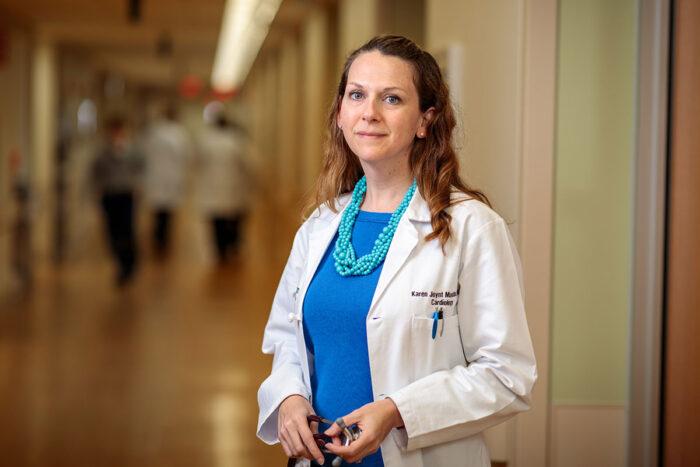Readmission penalties reduced for hospitals with poorest patients

Credit: Matt Miller
New Medicare reimbursement rules provide some relief to safety-net hospitals, shifting the burden of financial penalties toward hospitals serving wealthier patient populations, according to a new study led by Washington University School of Medicine in St. Louis. The new rules also reduce the burden of such penalties on hospitals in states that have more generous Medicaid programs.
The study, conducted by researchers at Washington University, the Missouri Hospital Association and the Henry Ford Health System in Detroit, is published April 15 in JAMA Internal Medicine.
In an effort to reduce health-care costs, Medicare issues financial penalties via the Hospital Readmissions Reduction Program (HRRP) to hospitals with higher than expected readmission rates. The program — which can cut a hospital’s Medicare reimbursements by up to 3 percent — has been criticized for unfairly penalizing so-called safety-net hospitals that serve the poorest patients, who are more likely to be readmitted for reasons beyond the hospital’s control.
Rather than comparing all hospitals directly, the new rules divide hospitals into five groups according to the proportion of their Medicare patients who are also enrolled in Medicaid, a program intended to help the poorest patients. Hospitals are then only compared to their peers that treat similar proportions of disadvantaged patients. Across the five groups of hospitals, the average proportion of patients dually enrolled in Medicare and Medicaid ranged from a low of 9.5 percent to a high of almost 45 percent.
“The new rules recognize the reality that it is harder to prevent readmissions when people don’t have stable housing or social support,” said Washington University cardiologist Karen Joynt Maddox, MD, the study’s first author and an assistant professor of medicine. “If you have patients who struggle to put food on the table, it’s going to be tougher for them to manage their end-stage heart failure. The old system took money away from hospitals that serve the most vulnerable patients. It created a significant disincentive to provide health care to poor people, and that’s the last thing we want.”
Looking at the most recent data published by the Centers for Medicare & Medicaid Services, the researchers calculated and compared the penalties under the old and new reimbursement rules for just over 3,000 hospitals nationwide. Using the published data, the researchers projected how the penalties will shift by comparing projected penalties under the new rules to what they would have been under the old rules. Under the new rules, penalties for the hospitals serving the fewest poor patients are projected to increase more than $12 million in total. Meanwhile, penalties for the hospitals serving the highest proportion of poor patients are projected to decrease by more than $22 million in total. On an individual hospital level, the changes are projected to range from an increase in penalties of $225,000, to a decrease of $436,000.
Large hospitals and teaching hospitals are the most likely to see reduced penalties. The researchers also found reduced penalties among hospitals serving patients from the most disadvantaged neighborhoods and those serving the most patients with disabilities. Hospitals in states with more generous Medicaid enrollment also fare better than those in states with fewer poor patients enrolled in the Medicaid program.
“States differ widely in the percentage of people living in poverty who are able to enroll in Medicaid,” Joynt Maddox said. “Since the new rules, as written by Congress, only give credit to hospitals for treating patients on Medicaid and not poor patients in general, the states with more people enrolled in Medicaid are going to benefit more from the new system.”
According to Joynt Maddox, the researchers were surprised at the magnitude of the state and regional differences in the shift in penalties, with more penalties for hospitals in the South and Midwest and fewer penalties for hospitals in the West and Northeast. California, which has generous Medicaid enrollment, had the most reduced penalties. Meanwhile, South Dakota and Florida, two states with fewer poor patients enrolled in Medicaid, had the greatest increases. Overall, much of the shift in penalties between states could be explained by differences in state Medicaid enrollment.
“This was a positive change for the HRRP,” Joynt Maddox said. “Making the program more fair doesn’t take away from its goal, which is to use financial incentives to make hospitals think differently about care beyond their walls. Hospitals are increasingly working to provide a soft landing, including discharge planning and communication with outpatient-care providers.”
Still, Joynt Maddox said there is work to be done, even if the new rules more fairly consider the socioeconomic reality of hospitals’ patient populations.
“There are still marked disparities in readmissions related to social determinants of health,” she said. “We need to find innovative solutions to improve outcomes for our most vulnerable patients after they leave the hospital.”
###
Joynt Maddox reports intermittent contract work for the U.S. Department of Health and Human Services.
This work was supported by the National Institutes of Health (NIH), grant numbers R01MD010243 and RF1AG057784; and by the Washington University School of Medicine Office of Medical Student Research Dean’s Fellowship.
Joynt Maddox KE, Reidhead M, Qi AC, Nerenz DR. Association of stratification by dual enrollment status with financial penalties in the hospital readmission reduction program. JAMA Internal Medicine. April 15, 2019.
Washington University School of Medicine’s 1,500 faculty physicians also are the medical staff of Barnes-Jewish and St. Louis Children’s hospitals. The School of Medicine is a leader in medical research, teaching and patient care, ranking among the top 10 medical schools in the nation by U.S. News & World Report. Through its affiliations with Barnes-Jewish and St. Louis Children’s hospitals, the School of Medicine is linked to BJC HealthCare.
Media Contact
Julia Evangelou Strait
[email protected]
Original Source
https:/




